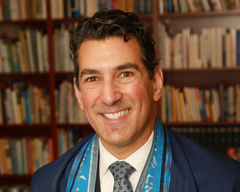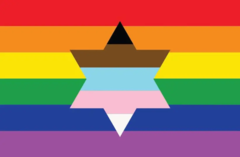how we live right now
09/15/2021 10:10:51 PM

Sermon - Kol Nidre 5782
In the coming years, I can only imagine how many studies and books that will be published trying to make sense of this era. What will sociologists make of this epoch and how will it be regarded decades from now for its impact on society? And how will it impact Jewish life and thought? One thing that has recently become clear to me through our Jewish texts is this: brokenness is a part of our people’s narrative. It was baked into our story from the beginning, and we are all the inheritors of that message.
Our earliest stories as a people include Moses coming down the first time from Mount Sinai and carrying the tablets on which were carved the Ten Commandments. He came upon the Israelites dancing with a golden calf—a symbol of the idolatry they were to have left behind, furious, Moses threw the tablets to the ground, and they shattered into pieces.
All was not lost, though. Soon God would beckon Moses to come up again to the top of the mountain for another forty days. The rabbis of the Talmud tell us that the day he came down the mountain with the second set of tablets, was this day, Yom Kippur, the Day of Atonement. The whole tablets, then, are clear signal that the brit, the covenant, was still intact. The covenant between God and Children of Israel was still whole, and thus God had forgiven Moses for breaking the original tablets and had forgiven the people for apostasy. Brokenness and forgiveness, in this way, go hand in hand. And Yom Kippur brings with it the life-renewing, hope-restoring, and energy-giving message that God’s forgiveness, fresh starts, and life’s renewal are within reach.
In the Talmud, Rav Yosef teaches that the whole set of tablets and the broken tablets were placed in the ark that the Israelites carried with them through the desert.[1]
Why would they carry broken shards—the reminder of a dark moment of transgression—with them? The sages teach us that this was to remind them—and all of us—that we carry the sum of our experiences, the good ones and the painful ones, the best and the worst of us—all our moments,—the ones we are proud of and the ones which may pain us days or even decades later.
In the poem The Broken Tablets, by Rodger Kamenetz he sheds light on how we all carry our brokenness:
The broken tablets were also carried in an Ark.
In so far as they represented everything shattered
everything lost. They were the law of broken things. . .
How they must have rattled around until the pieces
broke into pieces. The edges softened
crumbling. Dust collected at the bottom of the ark . . .
And in so far as memory preserves the pattern of broken things
these bits of stone were preserved
through many journeys and ruined days
even, they say, into the promised land.[2]
Our tradition has a teaching that all that occurred to our ancestors will occur to members of our people as well. Covenantal moments, exile, atonement, displacement, love, and peace. These will happen not just in our people’s lives, but to all of our lives as well. In this way, brokenness is not just our people’s earliest narrative. It’s our individual narratives as well.
Some of you may recall that I ended my Rosh Hashanah remarks with the theme of brokenness. I heard from many of you that you resonated with that notion, especially this year. And I do too. So, I wanted tonight, to delve in more deeply and not simply acknowledge our brokenness but to help us think of how we hold that brokenness and what we do with it – especially on this holiest of days.
When I was a teenager, my older sister, Cindy, comforted me once with the words that our lives are one big mosaic, and every experience, the good ones, and the not so good ones, are one more piece of something that will be beautiful. Our lives are like a magnificent mosaic that only we could create.
And in this mosaic, it’s all out there, every big and little piece. Those that have been intentionally crafted into a gorgeous piece, and the accidentally broken shards. In this vision of our lives, there can be no omissions, there is no whitewashing history, there is no fooling ourselves, and there is no fooling God either. There we are. There our lives are in front of us. We are broken, and we make a whole. We are authentic, and that’s the way it’s intended to be.
Sixteenth century scholar Rabbi Eliyahu de Vidas wrote, “The Zohar teaches that the human heart is the Ark. And it is known that in the Ark were stored both the Tablets and the Broken Tablets. Similarly, a person's heart must be full of Torah . . . and similarly, a person's heart must be a broken heart, a beaten heart, so that it can serve as a home for the Shechinah [divine presence]. For the Shechinah only dwells within broken vessels, which are the poor, whose heart is a broken and beaten heart. And whoever has a haughty heart propels the Shechinah away from him . . .”[3]
How ironic that we spend so much care trying to build sturdy walls and defenses, and yet the Zohar teaches that it’s through our brokenness God come in – through our cracks. That’s how God’s light and presence come in. It’s our vulnerability that makes room for God in our heart. When we really think about what we’re doing on Yom Kippur, it’s all about admitting our brokenness, our cracks, our frailty. Our humanity, really. Our communal prayers, our singing, our beating our chest during the Cantor’s chanting of Ashamnu, it’s about admitting we have cracks and then opening our cracks wider. “Sh’ma Koleinu, Adonai Eloheinu,” we sing out. “Hear our voice, Adonai our God.” Hear our yearnings, hear our sins, hear our broken hearts, hear us clearly, dear God. “Do not cast us away from Your presence, or cut us off from Your holy spirit. Do not cast us away when we are old; as our strength diminishes, do not forsake us. Do not forsake us, Adonai; be not far from us, our God.” These are words of vulnerability and intensity, of hope and longing. We make ourselves whole by being honest, open, and by letting God in.
I have come to think that a great deal of our brokenness come from an unrealistic view of our place in the world. Many times throughout the pandemic I have felt that this experience is an object lesson in reframing how I look at my place in the world. So much is beyond my, or anyone else’s control. Confronting the reality that life is not certain is truly humbling and frightening. I’ve had to remind myself and, tonight, I will remind all of us, this is the human condition. We are not in control. And we rail against it and we fight against that reality. And that can lead us to feel only more broken. It’s not the world or the system is broken. It was created this way. And if we can admit that, then we can move through it more easily with greater peace and just maybe with a greater connection to God.
Author Michal Oshman writes that she was able to face her own brokenness when she realized she—and I would posit, all of us—are like the flame of a candle—always reaching, always dancing. Rabbi Shneur Zalman teaches, “[The soul] is comparable to the flame of a candle which, by nature, continually flickers upwards, because a fire’s flame is naturally inclined to detach itself from the wick. . . . And even though by leaving its wick, and uniting with its source, the flame would be extinguished, and would cease to shine at all down here . . . nevertheless, this is what the flame is naturally inclined to do.”
We are like that flame; we do what we are naturally inclined to do. As Oshman writes, “Like a flame, the soul can never be settled; it always flickers. My struggle, I thought, is really something quite beautiful: it is a symptom of always yearning to grow, like the flame which is pulled upward. I wasn’t a failure, I was just a beautiful flame.” As she continues, “Jewish wisdom points out a great universal truth: that struggle is part of life. It’s not a bug in the system. Life was designed this way. This is the system! And although it took me a long time to realize it, there is no life or growth without internal and external tension.”[4]
And that speaks to the fullness of this holy day. It is a deeply internal and personal time, but each one of us, and we as a whole, are also impacted by the external. There are no islands here. We are all in this together. And at this time in particular, we are facing wave after wave of external events and forces. There is no life or growth without internal and external tension.
Like Moses and the Israelites carrying the two sets of tablets throughout their journey, we too carry our broken and whole tablets on our journey. And may that awareness allow us to let in the light of God. For it is with our broken and whole parts together that we will face the New Year.
Listen to these words of musician Leonard Cohen:
Ring the bells that still can ring
Forget your perfect offering
There is a crack in everything
That's how the light gets in.[5]
May this day bring you closer to the light of God as we bare our souls and open our hearts on this day of atonement. So may this be God’s will. Cain yehi ratzon. Amen.






